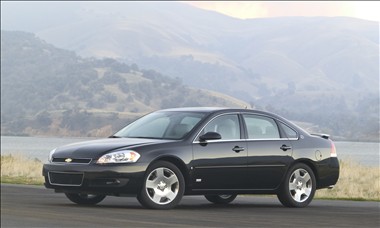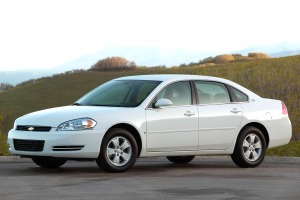
In today's automotive market, where the prices of newer used cars have surged, many buyers are considering older models as a cost-effective alternative. And by "older", I am generally referring to 10+ year-old vehicles.
One such option is the ninth generation Chevrolet Impala, produced between 2006 and 2016. Known for its spacious interior, reliable performance, and affordable price point, the Impala can offer an attractive blend of features for budget-conscious consumers.
However, purchasing an older vehicle comes with its own set of advantages and potential drawbacks, with its reliability and durability being of utmost importance.
So, here, ...
- First, we'll look at the reliability of the Chevrolet Impala's ninth generation, produced from 2006 - 2016.
- We'll then list possible mechanical issues that have been reported by some owners so they can be checked before buying one today.
- Then we'll do an overview of this Impala's features and characteristics so potential buyers can get to know the vehicle better.
- We'll then review the overall pros and cons of buying an older Impala today.
- And then finish up with a suggested maintenance schedule for this version of Impala.
But first, two very important suggestions ...
1. Things To Do When Considering An "Older" Impala:
Locate Lower Mileage Vehicles: They are certainly out there to be found with careful and patient shopping. Be willing to drive a distance if you have to.
Vehicle History and Maintenance: Ask for the vehicle history report (CarFax or AutoCheck) as well as documented maintenance and repair records. If not provided by the dealer or private seller, it's best to move on.
Pre-Purchase Inspection: Have the vehicle independently inspected before making a final decision. This usually will cost in the $150-$200 range but is well worth it given the potentially thousands in savings over the long term.
2. Know How To Get The Lowest Used Car Price:
Get Dealers To Compete For your Business: When you are searching vehicles to possibly purchase, the following is the absolute best way to get the lowest price, and it is extremely easy and stress-free.
Just go to a national car listing site, (I happen to prefer CarsDirect.com for their massive dealer participation and ease of use, although others will get the job done as well) and find several listed vehicles that you may be interested in.
Then write something like the following in the "Check Availability" box or "Contact Dealer" box or whatever the site you are using uses.
"Hello, I've contacted several dealers about cars I am interested in and am looking for the best value. I am also a serious buyer planning to make a decision soon. Please send me your best out-the-door price. Thank you.
After receiving the offers, follow up by explaining that based on the price, you're leaning in another direction but still really like their car and would certainly consider another offer. When dealers drop out, you'll know you're at the best price.
Using the internet to get dealers to compete for your business is extremely important. More details on this and how to intereact with the dealers can be found here at Best Used Car Buying Techniques.
2006 - 2016 Chevy Impala Reliability
Several factors indicate that the ninth-generation Chevrolet Impala is generally considered a reliable vehicle:
Strong Engine Performance: The 3.5-liter and 3.9-liter V6 engines are known for their durability and relatively few serious issues. The later models equipped with the 3.6-liter V6 engine offer good performance and reliability, with fewer reported problems compared to earlier engine options.
Longevity and High Mileage: Many Impalas from this generation have been known to reach high mileages (over 200,000 miles) with proper maintenance, indicating long-term durability and reliability. Again, the key is "proper maintenance".
Positive Owner Reviews: A significant number of owners have reported positive experiences regarding the car's longevity and dependability.
Low Maintenance Costs: The Impala is relatively inexpensive to maintain compared to some of its competitors. Parts are widely available and reasonably priced, making repairs and routine maintenance more manageable.
Build Quality: The Impala has a robust build quality, which has contributed to its reliability.
Few Major Recalls: The ninth-generation Impala has not been plagued by an excessive number of major recalls, suggesting fewer widespread serious issues.
Professional Reviews: Automotive reviews from reliable sources like Consumer Reports and J.D. Power have often rated the Impala favorably for reliability, especially the later models of this generation.
Maintenance Records: Vehicles with thorough maintenance records demonstrate a history of care, which is crucial for assessing the reliability of used cars. Impalas that have been regularly serviced according to manufacturer recommendations tend to be more reliable.
Common Issues are Manageable: While the Impala does have some common issues, these are generally well-documented and can be managed with regular maintenance and timely repairs. Awareness of these issues also allows owners to take preventive measures.
Possible Chevy Impala Mechanical Problems
The ninth generation Impala, while generally reliable, has had some more common mechanical issues that prospective buyers should be aware of and include in a pre-purchase inspection. These are far from universal but have been reported by some owners:
Transmission Problems: Some owners have reported issues with the transmission, particularly in models with the four-speed automatic. Symptoms include harsh shifting, slipping, and, in some cases, complete transmission failure.
Intake Manifold Gasket Leaks: Some of the 3.5-liter and 3.9-liter V6 engines have experienced intake manifold gasket leaks, which can lead to coolant leaks and engine overheating.
You May Also Like:
The Easiest Car Negotiation Technique
Best Time To Buy And How To Negotiate
All About Wholesale Car Prices
Power Steering Issues: Problems with the power steering system have occurred, including leaks and failures of the power steering pump, which can lead to a loss of steering assist.
Electrical Issues: Various electrical problems have been reported, such as malfunctioning power door locks, window regulators, and issues with the body control module (BCM) that can affect multiple electronic functions.
Suspension Problems: Some owners experienced issues with the suspension components, including premature wear of struts, control arms, and sway bar links, leading to clunking noises and a rough ride.
Coolant Leaks: Apart from the intake manifold gasket, other components such as the radiator, heater core, and coolant cross-over pipe gaskets may also leak, which can cause engine overheating and damage.
Timing Chain Wear: The 3.6-liter V6 engine introduced in later models can experience timing chain wear and stretching, which can lead to poor engine performance and, in severe cases, engine damage.
Oil Consumption: Some owners report excessive oil consumption, particularly with the 3.6-liter V6 engine, which can lead to the need for more frequent oil top-offs and potential engine damage if not monitored.
Brake System Issues: Problems with the brake system, such as premature wear of brake pads and rotors, and issues with the ABS system, have been reported.
Fuel System Problems: Issues with the fuel system, such as fuel pump failures and problems with the fuel level sensor, can lead to inaccurate fuel readings and potential stalling.
Failed Solenoids: Solenoids are electric-powered valves that control how much transmission fluid can flow into the transmission.
Defective Torque Converter: This can cause shuddering or vibrating and can cause the engine’s RPMs to run high, worsening gas mileage.
Accelerator Position Pedal Sensor Malfunction: This produces an engine reduced power light and difficulty accelerating.
Seatbelt Pretensioner Problems: Some owners have reported that seatbelt pretensioners located at the base of the seatbelt have malfunctioned.
Rear Alignment Issues: Some Impala models have been known to have rear alignment problems, which can lead to uneven tire wear and other issues if not addressed.
Ninth Generation (2006 - 2016) Chevrolet Impala Overview

This Impala version was large enough to seat six, yet toned down in engine size to a more gas-friendly V6, while still producing plenty of oomph with its 2011-horsepower 3.5-liter engine. But for those who must have more get-up-and-go, you need look no further than the Impala SS (2006 - 2009) with its 5.3-liter V8 and an impressive 303 horsepower.
And if a compromise is in order, there's always the 3.9-liter V6 on the LTZ model making 240 horsepower.
And the drive of the Impala is smooth and quiet ... very impressive. It reminds me a bit of the Cadillac, but with a Chevy price.
Older Impala shoppers should note that it got a redesign for the 2012 model year with all models then being powered by a 3.6-liter direct-injection V6 that produces a lively 300 horsepower and 262 pound-feet of torque, while being coupled to a new six-speed automatic transmission (had been a rather outdated four-speed automatic) which improved fuel economy.
In the 2006 to 2011 models, the Impala was available in five trims: the entry-level LS, the midgrade LT or 2LT, the uplevel LTZ and the performance-oriented Impala SS. Safety features were upgraded over the previous generation to include standard antilock brakes (ABS), traction control, front seat side airbags, and side curtain airbags. In addition, stability control became standard on all but the LS and LT.
And you can start-up the engine with a simple touch of the key fob in LT and higher trims from this production run. This means you can get that air-conditioning going (or heater and window defroster, depending on where you are) while still in the comfort of your home to avoid those first few unpleasant minutes in the car.
And quite rare, and harkening back to its roots decades ago, the Impala LS can accommodate six passengers thanks to its front bench seat.
While there are slight variations by model year, typical standard features on the LS model include full power accessories, a power driver seat, keyless entry, 16-inch wheels, dual-zone air-conditioning, dual illuminated vanity mirrors, a front bench seat, OnStar, and a single-CD stereo system with an MP3 jack.
Opting for an LT model adds the remote vehicle start, alloy wheels, a compass, an outside temperature display, and floor mats, while the 2LT adds an alarm system, Bluetooth connectivity, steering wheel audio controls, 17-inch alloy wheels, foglights, a rear spoiler, heated mirrors, fold-down rear seats, and a leather-wrapped steering wheel.
Moving up to the LTZ adds a performance-tuned suspension, 18-inch 5-spoke alloy wheels, leather upholstery, heated bucket seats, an auto-dimming rearview mirror, and a Bose stereo, while the SS comes with the performance-tuned suspension, the 5-spoke 18-inch wheels, monochromatic exterior paint, and a unique front-end appearance that includes a dual-split grille with a SS-signature black-diamond crosshatch pattern.
The update for the 2012 model year brought the more powerful engine and the six-speed automatic transmission. All of these Impalas came with traction control, stability control, antilock brakes, front seat side airbags, and side curtain airbags.
Pros And Cons of Buying an Older Chevy Impala Today
Chevy Impala Pros:
Affordability: The 9th generation Impala is an older model, which means it's likely to be more affordable than newer used cars and have a lower upfront cost.
Proven Track Record: The ninth generation Impala is known for its reliability, especially when well-maintained. Many owners have reported high mileage without major issues.
Durable Engines: The V6 engines, particularly the 3.5-liter and 3.9-liter variants, have been largely proven to be durable and reliable while offering good power and acceleration.

Low Maintenance Costs: Parts for the Impala are widely available and reasonably priced, making maintenance and repairs more affordable.
Simple Mechanics: Compared to newer cars with complex systems, the Impala’s mechanics are relatively straightforward, which can reduce labor costs for repairs.
Safety Features: Later models come with essential safety features such as ABS, stability control, and multiple airbags.
Lower depreciation: In most models, the initial depreciation hit has already occurred, so the value of the vehicle will decrease more slowly over time, lowering the overall cost of ownership.
Lower insurance costs: Insurance premiums are often lower for older vehicles.
Spacious Interior: The Impala offers a roomy cabin with ample space for both front and rear passengers, making it comfortable for long trips.
Large Trunk: It boasts a sizable trunk, providing plenty of storage space for luggage and other cargo.
Comfortable Ride: The Impala is known for its smooth and comfortable ride, making it a good choice for highway driving and daily commutes.
Bench seats: The Impala's bench seats provide ample space for passengers, making it a great option for families or those who frequently transport multiple passengers.
Quiet interior: The Impala's interior is designed to be quiet and peaceful, reducing outside noise and providing a serene driving experience.
Relatively cheap on gas: The Impala has a decent fuel economy, with an estimated 22-30 MPG in the city and 30-35 MPG on the highway, depending on the engine and transmission.
Chevy Impala Cons:
Potential For Higher Maintenance Costs: While maintenance costs are well understood, older vehicles may require more frequent repairs and replacements, potentially offsetting some or all of the upfront savings.
Safety Features: While they have basic safety features, they lack more modern safety technologies such as advanced driver-assistance systems (ADAS) found in newer vehicles.
Lower Fuel Economy: The V6 engines are not as fuel-efficient as some newer cars, which can lead to higher fuel costs over time.
Interior Quality: While spacious, the interior materials can feel subpar compared to some competitors, with lots of hard plastics and a somewhat dated design.
Handling and Performance: The handling is adequate but uninspired, with a focus more on comfort than sporty performance. The steering can feel somewhat numb and disconnected.
Dated Technology: Earlier models of the ninth generation lack modern infotainment systems and connectivity features that have become standard in newer vehicles. Even later models can feel outdated in this regard.
Transmission: The four-speed automatic transmission in earlier models is outdated compared to the six-speed automatic introduced in 2012, which offers better performance and fuel efficiency.
Non-Bose Stereo And Speakers: The base model Impala's stereo and speakers are not as high-quality as some other vehicles, which may be a drawback for music lovers.
Older Chevy Impala Maintenance Recommendations:
Oil Changes: Every 3,000-5,000 miles for conventional oil, or 7,500-10,000 miles for synthetic oil.
Transmission Fluid: Change every 30,000-40,000 miles.
Coolant: Flush and replace every 60,000-70,000 miles.
Brakes: Inspect regularly and replace pads and rotors as needed, typically every 25,000-35,000 miles for pads.
Tires: Rotate every 5,000-8,000 miles and replace as needed, usually every 40,000-50,000 miles depending on tire type.
Timing Chain/Belt: The Impala’s engines generally use timing chains, which last longer than belts but should still be inspected for wear around 100,000 miles.
By adhering to these maintenance guidelines and addressing any issues promptly, a ninth generation Chevrolet Impala can provide reliable and long-lasting service for many years and miles.
 By Josh Rosenberg
By Josh Rosenberg